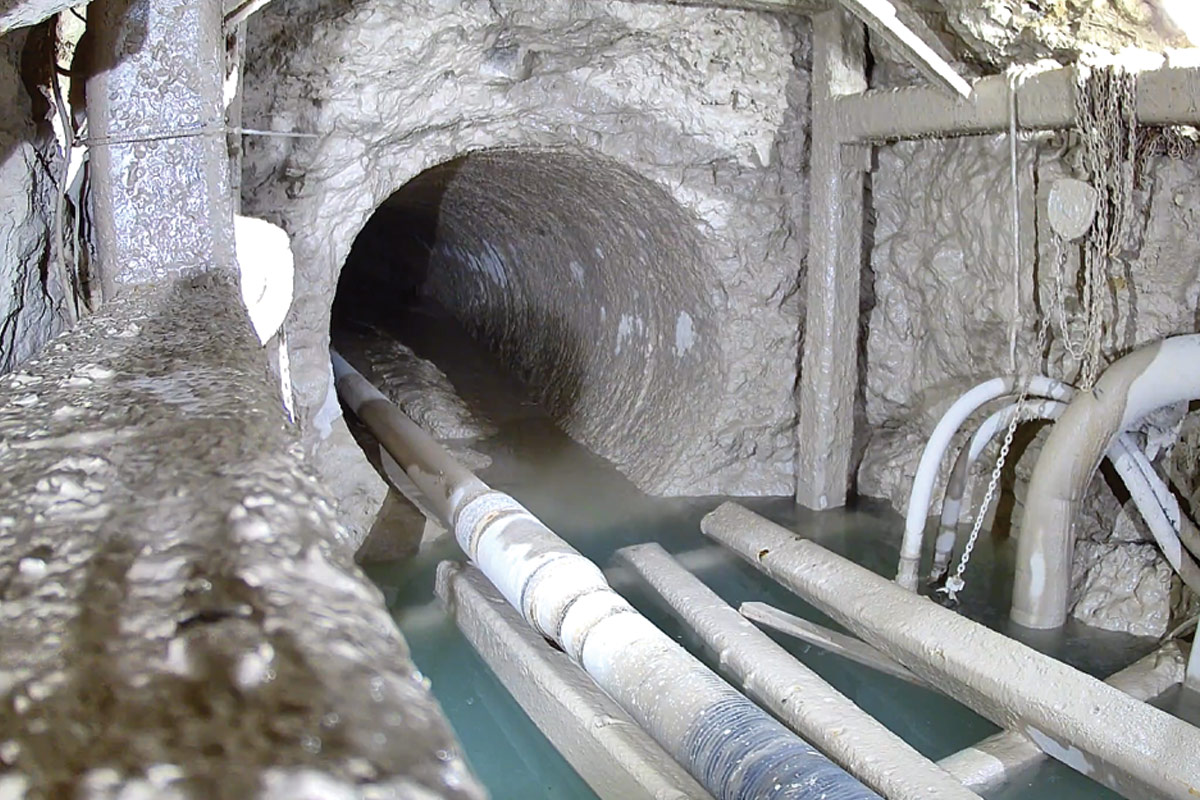
What Is the Outlook for Water and Sewer Construction in the New Year?
January 19, 2016
“The environment is too chaotic to predict. Remain calm, all is well.” Our opening quote is from an executive answering the survey for the FMI Nonresidential Construction Index Q4, 2015 (NRCI). To put the comment in context, it is a response to our question about economic uncertainty. The “environment” is the economy, not the weather or something geological. If you spend any time reading the headline news these days, you will understand what the writer means about geopolitical and economic chaos and why he felt it was necessary to add, “Remain calm, all is well.” As we found in the NRCI survey results for the fourth quarter, not all is well, but it is not that bad either.
The NRCI dropped four points from the previous quarter to 59.5. Panelists have dropped their outlook for the economy in general, but they are still within a range expecting growth in the coming year. Some of the reasons forming their opinions can be gleaned in our “current issues” questions concerning uncertainty, optimism levels and shortages of skilled workers. Compared to the same questions last year for uncertainty and optimism, panelists haven’t changed their ratings much. They continue to be moderately uncertain about what will happen in the economy in the coming year or so, and, at the same time, they continue to be quite optimistic, but cautious. The drop in the NRCI score for the last two quarters doesn’t make a trend, although it should raise concerns.
The construction industry has been on a good run, and most expect it to continue. However, some think the momentum is beginning to slow. Then there is the political season beginning to ramp up where we will be reminded of both good and bad news for the economy.
Perhaps Charles Dickens said it best in his great opening to “A Tale of Two Cities.” “It was the best of times, it was the worst of times. . .” He was writing of a time of revolution when the world was bifurcated between rich and poor, slaves and slaveholders and a world of differences causing strife and war. He suggested the situation might parallel with his times (circa 1859), but there is no way he could have been predicting our times, could he?
 NRCI Fourth Quarter 2015 Highlights
NRCI Fourth Quarter 2015 Highlights
Overall Economy:
NRCI panelists’ outlook for the overall economy dropped sharply for Q4, down 12.3 points from last quarter to 58.3.
Overall Economy Where Panelists Do Business:
The NRCI component for panelists’ own business dropped less sharply than for the overall economy, from 73.3 to 64.8 this quarter, but still a sign that expectations have been lowered as we head into the new year.
Panelists’ Construction Business:
Panelists’ business, for the most part, is carrying good momentum as business has been improving, but the momentum is beginning to slow to drop this component by 5.8 points to 69.9, still in strong growth territory.
Nonresidential Building Construction Market Where Panelists Do Business:
While most panelists report their own business as holding strong, their opinion of the general nonresidential construction market is less exuberant this quarter, moving from 75.7 to 65.3.
Expected Change in Backlog:
Backlogs for those participating in the NRCI survey have reached the highest level since we started this report. Now at a median of 12 months, panelists expect that rate to cool in 2016 as the component score dropped from 68.2 to 62.2 this quarter.
Cost of Construction Materials and Labor:
The component for cost of construction materials was little changed from last quarter, improving 1.2 points to 30.6, indicating costs are still increasing. The cost of labor increased less sharply than last quarter, but it too is showing more increases. Generally, it is expected that costs will rise as business improves, thus holding down the overall NRCI index number.
Productivity:
Once again this quarter, there is little improvement in productivity, now at 47.9, or remaining under the midrange of 50. Productivity appears to be the most difficult area to improve, especially when backlogs are growing and it is difficult to find experienced workers to help grow the business.
Uncertainty Level:
We asked NRCI panelists about their level of uncertainty as it affects their future business outlook and found the results were not much changed from last year at this time. Compared to 2014, uncertainty levels are slightly lower. Nonetheless, on balance, construction executives answering our survey are still experiencing a moderate level of uncertainty about the future of the economy.
Uncertainty is generally characterized as a lack of information about the future, and what we think we know points to a situation that could turn bad or good at any time — but most likely bad. Much of the uncertainty comes from global unrest, terrorists’ threats and economies in distress. As another presidential race begins to heat up, uncertainty grows about our own economic future.
One of the interesting, or the least expected, situations that leads to uncertainty is success. We have seen something like this before in a study conducted by FMI in 2008, “Profiles in Success — How Contractors Define and Achieve Success.” As one panelist commented, “We are in a very strong market right now, but we are uncertain how long of a run we are in and are concerned with the flow of projects two years out.” Our experience or hunches often seem to tell us that if things have been going well for a long time, we must be due for a change in the other direction.
Optimism Levels:
Compared with 2014, panelists’ level of optimism has not significantly changed. They remain much more optimistic than pessimistic about the future of the economy. Although we found a number of areas that cause uncertainty, we continue to see considerable reasons for optimism from the same group. Compared with 2014, the top-three reasons for optimism are little changed. For instance, 19 percent of all responses chose “expanding backlog/future business” outlook as the top reason for being optimistic. Last year that category was second (15 percent), and “business starting to build again” was first (now second in 2015). “Most markets are growing” was the third choice for top reasons for optimism with 15 percent of all respondents. Sitting on the border of uncertainty and optimism, one panelist noted, “I am not sure if I am optimistic.” Most of us have likely had that feeling at one time or another. Those who seem to be the most optimistic are the leaders that grab the bull by the horns, as one contractor commented: “We are working hard to develop a strategic plan that allows us to continue to thrive in a changing construction environment. Business is changing, and it will be necessary to change with it in order for a firm to remain relevant.”
 Construction Forecast
Construction Forecast
After adjusting our construction forecast down a notch last quarter to 5 percent, we now expect 7 percent growth for 2016 to reach $1.09 trillion, the highest total since 2008, unadjusted for inflation. Manufacturing has been the rock star of 2015 and should come in at 18 percent growth for 2015. However, that pace is unlikely to continue, as we predict only 5 to 7 percent for 2016 through 2019. Manufacturing and industrial construction requires a long planning cycle in most cases; it also is a market that reflects global competition as countries strive to keep their workers employed and boost exports. Lower energy prices are, overall, beneficial to this sector, with the exception being mining and oil and gas construction, which has slowed since energy prices started dropping last year. Lower energy prices, along with a trained and available workforce and improved modes of transportation, also attract manufacturing. The completion of the Panama Canal will mean a boost for manufacturing in Gulf Coast states.
Other strong markets for 2015 include lodging, office and amusement and recreation, all experiencing double-digit growth. Multifamily construction has cooled to 11 percent for 2015. In the nonbuilding sectors, power construction continues to weaken with an expected 8 percent drop for 2015. As the U.S. per capita use of energy falls, the power industry is undergoing many changes due to changing fuel sources, new regulations and added capacity from renewable sources like solar and wind energy. The focus currently is on updating an aging fleet of power plants and adding peaking capacity. While transportation construction, largely driven by rail and airport renovation projects, is showing a sustainable growth of around 9 percent a year, highway and street construction continues to suffer budget uncertainties, and most work is being funded by states for necessary repairs to roads and bridges along with some key projects on major thoroughfares. The last-minute passage of a new five-year surface transportation bill should alleviate some of that uncertainty for the next few years until funding questions take the stage again.
While contractors, like the rest of us, will continue to keep an eye on the broader economy and plan accordingly, the challenges at this time are finding the right people to help complete current backlog and to help build the company for future growth.
As construction gets busier, productivity improvement becomes more of a challenge. Contractors are taking greater advantage of technology from BIM, communications advances and GPS to prefabrication, modularization and even robotics for dangerous and repetitive tasks like welding. This is still a small portion of the industry that is in the vanguard, but we expect to see these technologies and new business practices expand, especially in areas where it has been difficult to find skilled workers and highly competitive mar-kets. Productivity improvement will be critical, no matter which way the stock markets go in the coming year.
Philip Warner is a research consultant at FMI Construction.






